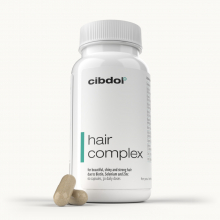7 signs of hair texture changes that could indicate a deficiency
Published:
Hair texture changes and hair loss could indicate vitamin deficiencies, thyroid issues, and other health problems. Here's what you need to know.
Contents:
- What Causes Changes in Hair Texture and Thinning?
- Changes in Hair Texture to Watch For
- What Should I Do If My Hair Texture Changes?
- Common Questions About Hair Texture Changes
- Summary
- To Summarize:
- What are the 7 signs of hair texture changes that could indicate a deficiency?
- What can cause your hair to change?
- What does it mean if my hair looks brittle?
- Can vitamin deficiencies lead to hair loss?
- How does my scalp health impact my hair?
- What can I do to keep my hair healthy?
- Can a deficiency in thyroid hormone cause hair thinning?
- What should I do if I noticed changes in my hair texture?
- Can vitamin deficiencies cause my hair to turn gray prematurely?
- What does it mean if I see a lot of hair in the drain?
We all have bad hair days occasionally, but have you noticed more consistent changes in your hair texture recently? Is your hair looking thinner or more brittle? Are you finding more strands than normal in your hairbrush or shower drain?

Changes in your hair texture or unexplained hair loss could be a sign that something is off with your health. While some amount of hair shedding is normal, a sudden increase in hair falling out or changes in texture like new frizziness or limpness can indicate an underlying issue.
In this article, we'll explore some of the key reasons your hair texture and thickness may change, including vitamin deficiencies, thyroid disorders, stress, hormonal imbalances, and autoimmune diseases. We'll also provide tips to help bring your hair back to health. Keep reading to learn what your hair could be trying to tell you about your overall wellbeing.
What Causes Changes in Hair Texture and Thinning?
Hair texture and thickness is largely determined by genetics, but other factors like nutrition, hormonal changes, inflammation, and disease can cause noticeable changes in the hair. Here are some of the most common culprits of hair texture changes:
Vitamin or Mineral Deficiencies
Not getting enough key vitamins and minerals can lead to hair texture changes and increased shedding. Some of the main nutrient deficiencies linked to hair problems include:
- Iron deficiency or anemia - Iron is necessary for producing hemoglobin in red blood cells that carry oxygen to hair follicles and skin. Low iron levels lead to decreased oxygen supply, which can cause hair to thin and shed more easily.
- Vitamin D deficiency - This vitamin is crucial for hair follicle cycling and growth phases. Deficiency has been linked to alopecia or hair loss. Getting enough vitamin D from sun exposure, foods or supplements supports healthy hair.
- Biotin deficiency - Biotin is a B vitamin that is essential for hair health. Inadequate biotin intake can lead to brittle, thinning hair.
- Vitamin B12 deficiency - Lack of this nutrient essential for red blood cell formation can trigger hair loss and texture changes. Vegans and vegetarians may be at risk for deficiency.
- Zinc deficiency - Zinc is needed for protein synthesis and cell division. Low levels have been tied to hair shedding and thinning hair.
Thyroid Disorders
The thyroid hormones triiodothyronine (T3) and thyroxine (T4) are essential for proper metabolism and cell growth. Hypothyroidism, also known as underactive thyroid, is a common cause of hair loss and dry, brittle hair texture. Hyperthyroidism can also prompt hair changes. Treating the thyroid condition helps restore normal hair growth.
High Stress Levels
Ongoing stress prompts increased cortisol and inflammation, which can exhaust hair follicle stem cells and impair regeneration. This stress-related hair loss is known as telogen effluvium. Managing stress and cortisol levels helps bring hair back into the normal growth phase.
Hormonal Shifts
Hormones like estrogen, progesterone, and testosterone support healthy hair. Changes related to childbirth, menopause or andropause can sometimes trigger extra shedding, thinning hair or texture changes. Hair normally recovers several months postpartum or when hormones rebalance.
Autoimmune Conditions
Diseases like lupus, alopecia areata and thyroid disease cause the immune system to mistakenly attack hair follicles, leading to often-patchy hair loss and damage. Managing the underlying autoimmune condition helps minimize hair loss.
10 Changes in Hair Texture to Watch For
Keep an eye out for these common hair texture shifts that can signal an internal imbalance:
- Increased frizz or flyaways
- Limp, lifeless hair
- Coarse or wiry texture
- Thinning hair overall
- Hair that breaks more easily
- Lack of curl formation
- Dry, straw-like hair
- Frequent tangles
- New straight sections
- Sudden loss of volume
If you notice one or more of these changes in your hair's texture, it's a good idea to see your doctor to identify any underlying causes. Blood tests can check for anemia, thyroid problems or hormone imbalances. Your doctor may recommend supplements or treatment to get your strands back to normal.
What Should I Do If My Hair Texture Changes?
If your hair texture suddenly changes or if you notice thinning, shedding or breakage, here are some tips:
- See your doctor to identify any underlying issues, like nutritional deficiencies or thyroid disorders
- Ask for iron levels, vitamin D, thyroid function or hormone levels to be checked
- Consider taking supplements like biotin, vitamin D, iron or a multivitamin
- Reduce heat styling that could damage already fragile hair
- Try a hydrating hair mask to boost moisture
- Look for shampoos and conditioners that add protein
- Manage stress levels through yoga, meditation or counseling
- Improve diet by eating more lean protein, fruits, vegetables and healthy fats
- Check for scalp conditions like fungal infections or psoriasis
- Consider trying platelet rich plasma (PRP) therapy provided by dermatologists
With time and a boost to your overall health from lifestyle changes, supplements and treatment of any underlying issues, your hair should start regrowing and regain its normal texture. But be patient - it can take 6 months or longer to see significant improvement.
Common Questions About Hair Texture Changes
Here are answers to some frequently asked questions about shifts in hair texture and what they mean:
Why did my straight hair suddenly get curly?
Hormonal changes related to puberty, pregnancy or menopause can alter hair texture. Some hair also naturally becomes curlier with age as follicles shrink. Try a smoothing serum or blow dry to reduce frizz.
What causes wiry, coarse hair?
Thyroid disorders, vitamin deficiencies, and hormonal shifts linked to menopause/andropause can leave hair dry and coarse. Boosting moisture and nutrients helps improve texture.
Why is my hair so limp and flat lately?
Scalp conditions, hormonal changes, stress, hypothyroidism or lack of protein/iron can rob hair of volume. Treat any underlying imbalances and focus on volumizing products.
What makes hair more brittle and prone to breakage?
Lack of protein, biotin or iron can weaken hair. Thyroid issues and nutrient deficiencies also increase fragility. Minimize heat styling and boost moisture to improve elasticity.
Can anxiety or depression cause hair texture changes?
Yes, stress from mental health conditions prompts excess cortisol, inflammation and hair follicle changes. Hair normally rebounds after stress is eased through self-care, therapy or medication.
How long does it take to reverse hair texture changes?
It depends on the cause, but with nutrition adjustments, supplements, reduced styling damage and treatment of imbalances like thyroid disorders, texture often starts improving within 1-2 months, with more noticeable changes in 6-12 months.
Summary
Changes in your hair texture, from coarsening and increased frizz tolimpness and thinning, can be your hair's way of signaling that something is off. Common culprits include vitamin/mineral deficiencies, thyroid disease, hormonal shifts, stress and autoimmune conditions. See your doctor if hair texture changes last more than 6-8 weeks so any underlying problems can be diagnosed and treated.
With time, attention to overall health and scalp care, your hair follicles can bounce back and regain normal texture. Pay attention to your hair's condition as a clue to your overall wellbeing. With proactive treatment of any issues, you can get your strands smooth, shiny and healthy again.
To Summarize:
- Hair texture changes and thinning could signal nutritional deficiencies, thyroid disorders, hormonal shifts or high stress levels
- See your doctor for blood tests if hair alterations last more than 6-8 weeks
- Common causes include lack of iron, vitamin D, zinc or biotin
- Protein and fatty acid nutrition also essential for hair health
- Thyroid medications can help if hair changes are due to hypothyroidism
- Stress management and self-care helps minimize texture shifts
- Allow 6-12 months for improved texture once underlying factors are treated
- Go easy on heat styling and boost moisture to support hair recovery
Your hair provides visible insight into your health. By paying attention to changes in texture and getting to the root cause with your doctor, you can get your hair looking its best again.
What are the 7 signs of hair texture changes that could indicate a deficiency?
The 7 signs of hair texture changes that could indicate a deficiency include brittle hair, gray hair, hair loss, changes in your hair texture, hair thinning, hair shedding, and damaged hair.
What can cause your hair to change?
Various factors can cause your hair to change, including deficiencies in vitamins and minerals, thyroid disease, anemia, and changes in your overall health.
What does it mean if my hair looks brittle?
Brittle hair is a sign that your hair lacks moisture and essential nutrients. It can be caused by vitamin deficiencies, excessive heat styling, chemical treatments, and damage from harsh hair products.
Can vitamin deficiencies lead to hair loss?
Yes, deficiencies in certain vitamins can contribute to hair loss. Vitamin deficiencies, such as vitamin D, vitamin E, and vitamin B12 deficiency can cause your hair to become weak and prone to shedding.
How does my scalp health impact my hair?
Your scalp health plays a crucial role in the health and appearance of your hair. A healthy scalp provides a nourishing environment for hair growth, while an unhealthy scalp can lead to issues like dandruff, itchiness, and hair loss.
What can I do to keep my hair healthy?
To keep your hair healthy, it is essential to follow a proper hair care routine. This includes regular shampooing and conditioning, avoiding excessive heat styling, protecting your hair from harmful UV rays, eating a well-balanced diet rich in vitamins and minerals, and staying hydrated.
Can a deficiency in thyroid hormone cause hair thinning?
Yes, thyroid disease, specifically an underactive thyroid (hypothyroidism), can lead to hair thinning. Thyroid hormones play a crucial role in the growth and development of hair follicles, and an imbalance can disrupt the hair growth cycle.
What should I do if I noticed changes in my hair texture?
If you noticed changes in your hair texture, it is recommended to consult a hairstylist or a dermatologist. They can evaluate your hair and scalp health, identify any underlying deficiencies or conditions, and provide appropriate treatment or recommendations.
Can vitamin deficiencies cause my hair to turn gray prematurely?
While gray hair is primarily determined by genetics, certain vitamin deficiencies may contribute to premature graying. For example, vitamin B12 deficiency can affect the production of melanin, the pigment responsible for hair color.
What does it mean if I see a lot of hair in the drain?
Excessive hair shedding could be a sign of various underlying issues, including nutritional deficiencies, hormonal imbalances, or a type of hair loss called Telogen Effluvium. If you are worried about hair loss, it is best to seek professional advice for an accurate diagnosis and appropriate treatment.














